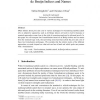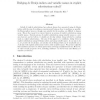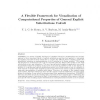12 search results - page 1 / 3 » A Head-to-Head Comparison of de Bruijn Indices and Names |
ENTCS
2007
13 years 4 months ago
2007
Often debates about pros and cons of various techniques for formalising lambda-calculi rely on subjective arguments, such as de Bruijn indices are hard to read for humans or nomin...
IGPL
1998
13 years 4 months ago
1998
Calculi of explicit substitutions have almost always been presented using de Bruijn indices with the aim of avoiding -conversion and being as close to machines as possible. De Bru...
ENTCS
2011
12 years 11 months ago
2011
SUBSEXPL is a system originally developed to visualise reductions, simplifications and normalisations in three important calculi of explicit substitutions and has been applied to...
IANDC
2007
13 years 4 months ago
2007
We introduce FMG (Fraenkel-Mostowski Generalised) set theory, a generalisation of FM set theory which allows binding of infinitely many names instead of just finitely many names...
HASKELL
2007
ACM
13 years 8 months ago
2007
ACM
The use of typed intermediate languages can significantly increase the reliability of a compiler. By type-checking the code produced at each transformation stage, one can identify...



